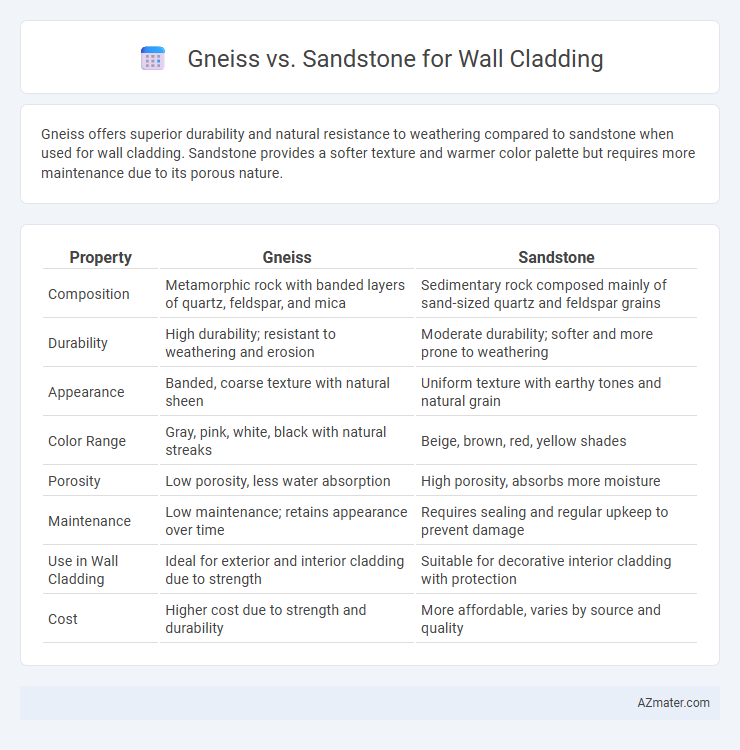Gneiss offers superior durability and natural resistance to weathering compared to sandstone when used for wall cladding. Sandstone provides a softer texture and warmer color palette but requires more maintenance due to its porous nature.
Table of Comparison
| Property | Gneiss | Sandstone |
|---|---|---|
| Composition | Metamorphic rock with banded layers of quartz, feldspar, and mica | Sedimentary rock composed mainly of sand-sized quartz and feldspar grains |
| Durability | High durability; resistant to weathering and erosion | Moderate durability; softer and more prone to weathering |
| Appearance | Banded, coarse texture with natural sheen | Uniform texture with earthy tones and natural grain |
| Color Range | Gray, pink, white, black with natural streaks | Beige, brown, red, yellow shades |
| Porosity | Low porosity, less water absorption | High porosity, absorbs more moisture |
| Maintenance | Low maintenance; retains appearance over time | Requires sealing and regular upkeep to prevent damage |
| Use in Wall Cladding | Ideal for exterior and interior cladding due to strength | Suitable for decorative interior cladding with protection |
| Cost | Higher cost due to strength and durability | More affordable, varies by source and quality |
Gneiss vs Sandstone: An Introduction to Wall Cladding Materials
Gneiss and sandstone are popular choices for wall cladding due to their durability and aesthetic appeal. Gneiss, a metamorphic rock characterized by its foliated texture and high hardness, offers superior resistance to weathering and structural strength compared to sandstone. Sandstone, a sedimentary rock with a granular surface and varied color palette, provides a softer texture and easier workability but requires more maintenance to prevent erosion and discoloration over time.
Geological Formation: How Gneiss and Sandstone Are Created
Gneiss forms through high-grade metamorphism, where intense heat and pressure transform pre-existing igneous or sedimentary rocks into foliated, banded textures rich in quartz, feldspar, and mica. Sandstone originates from the compaction and cementation of sand-sized mineral grains, primarily quartz, deposited by water or wind in sedimentary basins. Understanding these geological formations highlights gneiss's durability and unique patterns compared to the porous, layered structure of sandstone, influencing their performance and aesthetics in wall cladding applications.
Aesthetic Appeal: Visual Differences Between Gneiss and Sandstone
Gneiss exhibits a distinctive banded or foliated appearance with alternating light and dark mineral layers, creating a striking, textured visual effect ideal for sophisticated wall cladding designs. Sandstone features a more uniform, granular texture with warm earthy tones ranging from beige to reddish hues, offering a natural, rustic charm suitable for traditional or contemporary aesthetics. The choice between gneiss and sandstone impacts the overall ambiance of the space, with gneiss providing a dynamic, bold look and sandstone delivering subtle elegance and warmth.
Durability and Strength: Which Material Lasts Longer?
Gneiss exhibits superior durability and strength compared to sandstone due to its metamorphic origin, resulting in a denser, more compact structure resistant to weathering and abrasion. Sandstone, being sedimentary, is more porous and susceptible to erosion and mechanical wear over time, reducing its lifespan in exterior wall cladding applications. For long-lasting wall cladding, gneiss offers enhanced resistance to environmental stressors, ensuring a more durable and robust facade.
Weather Resistance: Performance in Various Climates
Gneiss exhibits superior weather resistance compared to sandstone due to its dense, foliated structure that withstands freeze-thaw cycles and heavy rainfall, making it ideal for harsh climates. Sandstone, while aesthetically pleasing with its granular texture, is more porous and susceptible to erosion and discoloration in wet or acidic environments. In regions with extreme temperature fluctuations or high humidity, gneiss maintains structural integrity longer, ensuring durability for exterior wall cladding applications.
Installation Process: Gneiss vs Sandstone Techniques
Gneiss wall cladding installation requires precise cutting due to its foliated texture and hardness, often necessitating diamond blade saws for clean edges and proper alignment to maintain natural veining patterns. Sandstone cladding typically involves easier cutting and shaping because of its softer composition, allowing faster installation with standard masonry tools while ensuring durability through proper sealing. Both materials demand secure anchoring systems, but gneiss may require heavier-duty fixings compared to sandstone to accommodate its greater density and weight.
Maintenance Requirements: Keeping Your Cladding Looking Its Best
Gneiss requires minimal maintenance due to its dense, durable structure, making it highly resistant to weathering and staining, ideal for long-lasting wall cladding. Sandstone, being more porous, demands regular sealing and cleaning to prevent moisture absorption and erosion that can lead to discoloration and surface degradation. Proper maintenance schedules and the use of appropriate sealants are essential for preserving the aesthetic appeal and structural integrity of sandstone cladding.
Cost Comparison: Pricing Gneiss and Sandstone for Projects
Gneiss typically costs between $3 to $7 per square foot, making it a mid-range option for wall cladding with high durability and unique veining patterns. Sandstone ranges from $5 to $10 per square foot, often priced higher due to its natural texture and versatility in various architectural styles. Project budget decisions should consider installation complexity and maintenance expenses alongside material costs for accurate cost comparison.
Sustainability and Environmental Impact
Gneiss offers superior durability and low porosity, reducing maintenance and increasing its lifespan as a sustainable wall cladding option. Sandstone, while aesthetically appealing, tends to be more porous and susceptible to weathering, potentially requiring more frequent replacement and environmental resources. Choosing gneiss over sandstone minimizes resource consumption and waste, promoting eco-friendly construction practices.
Best Applications: Where to Use Gneiss or Sandstone Wall Cladding
Gneiss wall cladding is ideal for outdoor facades and high-traffic areas due to its durability, resistance to weathering, and striking banded appearance that enhances modern architectural designs. Sandstone wall cladding excels in interior applications, patios, and garden walls where its natural texture and warm earthy tones create a rustic yet elegant ambiance, though it requires sealing to prevent moisture damage. For commercial buildings exposed to harsh climates, gneiss provides long-lasting strength, while sandstone offers aesthetic appeal for residential spaces with moderate environmental exposure.

Infographic: Gneiss vs Sandstone for Wall Cladding
 azmater.com
azmater.com